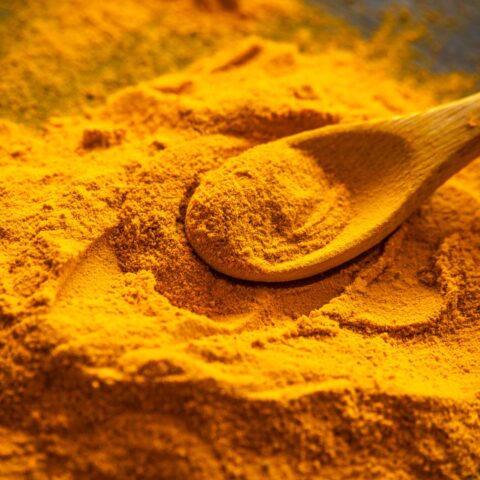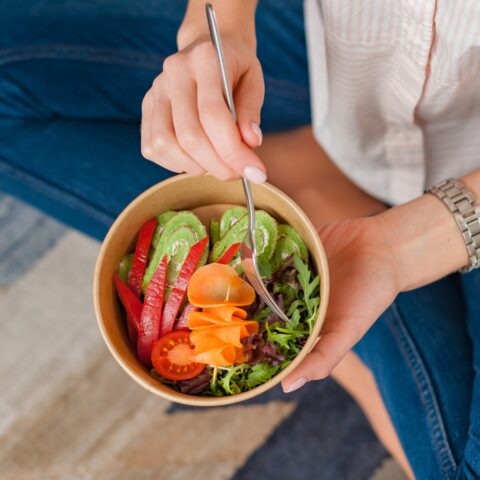Pemmican: A Plains Indians Staple Food that Prevented Protein Poisoning
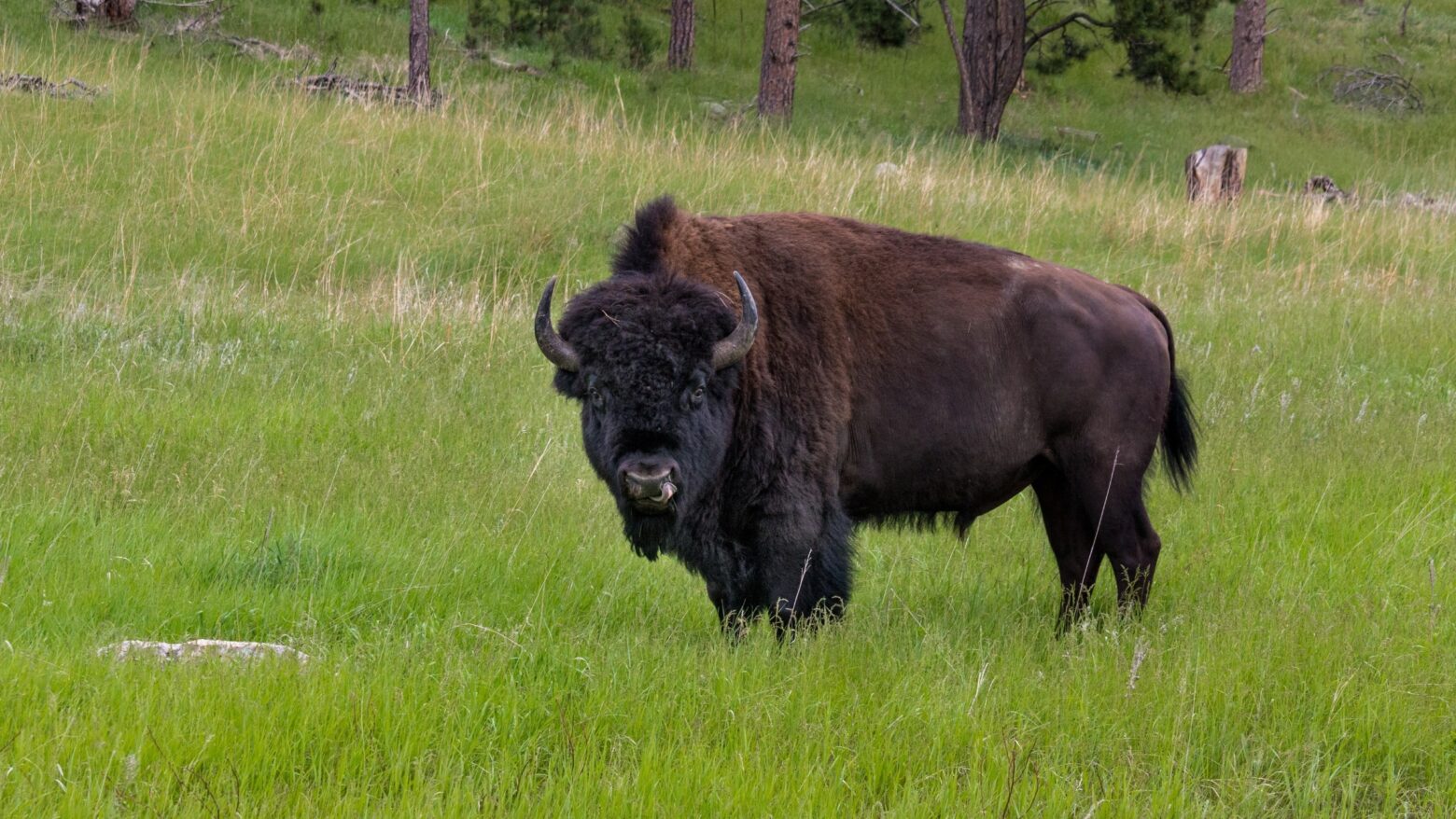
In a previous post, I demonstrated how the diets of North American Plains Indians during the 19th century allowed them to become the tallest humans in the world. All available evidence indicates1-4 that they ate a very high (76–85% of total calories) 1 animal-based diet throughout their lives, primarily from the consumption of buffalo (Bison bison) meat and organs.
With a high animal-based diet, one of the inherent problems that these peoples surely must have known was that unlimited and high consumption of lean bison meat only, or the lean muscle meat of any other wild game animal (elk, antelope or deer) is toxic. It produces symptoms of sickness and unease that can eventually lead to death.5-10 Early 19th-century explorers, frontiersmen, and trappers of the American West referred to this condition as “rabbit starvation.”5 It is now known that these symptoms result when the physiologic protein ceiling (~35 to 40% of eucaloric [normal] daily calories) is exceeded on a day-to-day basis.8-10
For all of us living in the 21st century, “rabbit starvation” is never an issue, and most of us are completely unaware of the condition. Few or none of us have ever been forced to eat lean, fat-depleted meat or fish as our only food source for even short periods. Nevertheless, for 19th-century frontiersmen, “rabbit starvation” could become a real problem, particularly when their “civilized” food supplies were depleted.5
However, for their Plains Indians counterparts, the physiological protein ceiling rarely or never became an issue because they had created a technology to prevent it. This technology likely developed through trial and error, and today is called “pemmican.”
Manufacture of Pemmican by Plains Indians
In our vast hi-tech society, we rarely consider the manufacture of a simple food as complex technology, but indeed the creation of pemmican by Plains Indians represented an elegant solution to an intricate physiological problem, for which the scientific community has only started to unravel in the past 15 years or so.9,10
It now seems likely that the Plains Indians had been manufacturing pemmican long before Europeans arrived in North America.11 The first European mention of pemmican comes from the Coronado expedition (1540-42) to southwestern parts of the present-day U.S., in which certain elements of pemmican manufacture were described.12 Definitive evidence of the first Europeans to witness the production of pemmican from Plains Indians comes from Henry Kelsey’s journal and travels (1691-92) to the prairies northeast of present-day Saskatoon, Canada and his observations of the Assiniboine people.13, 14
These historical archives leave little doubt that Plains Indians had developed a sophisticated technology to process bison meat and organs in a very specific manner. But why would they do so? Why not just eat fresh bison meat, or even just dried bison meat? To answer these questions, we must first get an accurate historical account of how pemmican was made. Perhaps the most comprehensive description of pemmican manufacture by North American Plains Indians is found in Stefansson’s book, “The Fat of the Land”15 in which he devotes five chapters9-13 to anything and everything about pemmican.
From Stefansson’s detailed descriptions15 to that of others,11-14,16 pemmican is nothing more than dried bison meat, pounded into small pieces and dried powder to which is added rendered, liquid bison fat, sometimes combined with indigenous dried berries. It’s a simple mixture, and let’s now move on—or should we? Is there something more to this simple mixture?
The devil is always in the details, and the manufacture of pemmican is no different. Let’s completely unravel this entire process from bison killing to pemmican consumption by North American Plains Indians.
Bison bison Killing
The North American buffalo (Bison bison) is a weird animal, at least from an anatomical perspective in that its right and left lungs are interconnected.16 Because of the absence of anatomical separation of the two hemi-thoraxes, an arrow or a single wound to one thorax frequently can result in bilateral tension pneumothoraxes (collapses of both lungs) and the incapacitation of the bison.16 Hence, for North American Plains Indians, a single arrow shot or spear throw to the chest of a buffalo, penetrating its chest, would almost certainly take it down.
Once they gained access to horses (during the 17th and 18th centuries),2, 4 and iron weapons from Europeans, North American Plains tribespeople would have increasingly represented a formidable force to take down the indigenous bison and use this resource for food. Plunging a spear or arrow into the thorax of a wild galloping bison (Plate 1 below) obviously takes skill, courage, and experience to kill these large beasts. Generally, this task fell upon adult males of North American Plains Indian Tribes. However, once the killing was done, the entire group of hunter-gatherers had to jump in and help with the butchering of the carcass and make it available for use and consumption by all.
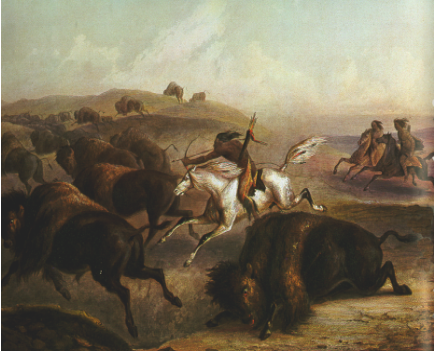
The average, wild cow (female) bison weighs in at about 1,000 lbs. and the average bull (male) at about 2,000 lbs.17 The males of Bison bison are the largest wild animals in North America, but surprisingly very little is known about the whole body fat composition in bison. Google Scholar reveals that no analyses of the body fat in adult bison have ever been undertaken or reported in the scientific literature.18
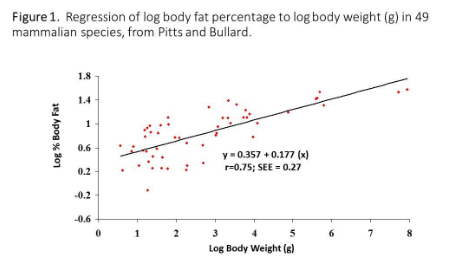
To understand how North American Plain Indians survived and prospered on a largely bison-based diet, we have to delve further into the whole body-fat content of adult bison and the nutrient composition of fresh bison meat, organs, and pemmican.
Although no quantitative studies have ever been conducted to determine the total body fat content in adult bison,18 good proximate values for bison body fat can be known by using scaling procedures in which the fat mass can be estimated by using the total mass (weight) of the animal.19, 20 In Figure 1 below, the Pitts and Bullard regression of body weight to %body fat can be used to estimate the total body fat % in adult bison by using the equation y = 0.357 + 0.177(x). The relative accuracy of this equation is demonstrated by its r = 0.75 (r2 = 0.56) and its standard error of estimation = 0.27% log body fat. Accordingly, the body fat % of a large adult cow bison (1000 lbs.) would be about 15%, and that of a large bull bison (2000 lbs.) would be approximately 17%.
Pemmican Production
What do these body fat % numbers mean, and why are they important in understanding how North American Plains Indians survived on a large bison based (~76-85%)1 diet? To fully understand this question, we must precisely know how the Plains Indians manufactured pemmican. Stefansson15 provides us with these crucial details:
1. Fresh, lean bison meat was cut into thin slices and laid out under the sun and wind to fully dry. Generally, it would take about 6 lbs. of fresh bison meat to make 1 pound of fully dried bison meat strips.
2. The next step was to pound the dried lean strips into shreds and powder upon a wooden or stone block with either wooden or stone hammers.
3. Next came the manufacture of a rawhide bag which was cut from the bison’s hide to store the pemmican. The bag was about the size of a modern pillowcase with the hair outside. When filled, it weighed about 90 lbs.
4. The shredded and powdered lean bison meat was put into a bowl or the rawhide bag itself. Cooked, boiled, and rendered bison fat was poured onto the dried bison meat and kneaded into a uniform mixture.
5. The preferred rendered fat was marrow, but subcutaneous storage fat was also used or a combination of the two fats.
6. The ratio (by weight) for the mixture of dried bison meat to rendered fat was 1 to 1 (e.g., a pound of dried bison meat was mixed with a pound of rendered fat).
7. In some tribes, before contact with Europeans, occasionally pemmican batches included the dried wild fruit of chokecherries (Prunus virginiana), buffalo currants (Ribes odoratum), Saskatoon berries (Amelanchier alnifolia) and/or buffalo berries (Shepherdia argentea). 21
Implications of Plains Indians Pemmican Manufacture
The ratio of dried bison meat to rendered marrow or subcutaneous fat was not a hit and miss process. Rather, it represented a well thought out strategy that had to be close to a 1 to 1 mixture to prevent protein poisoning. The best available evidence indicates that the human physiological protein ceiling lies at about 30% to 40% of iso-energetic (normal) calories.9, 10 Accordingly, when pemmican was manufactured if it exceeded 40% of its calories as protein, it would become toxic if consumed in unlimited amounts.
Let’s do the math and see how one pound of dried bison meat mixed with one pound of marrow translates to a protein to fat caloric ratio. Does this ratio exceed the physiologic protein ceiling (40% of total calories) or not?
Calculations:
1. 6 lbs. of fresh bison meat = 1 lb. of dried bison meat
2. 1 lb. of dried bison meat is mixed with 1 lb. of rendered fat (marrow or storage fat) to manufacture pemmican
3. 1 lb. of dried bison meat = 293 g protein and 20 g fat
4. 1lb. rendered bison marrow = 30 g protein and 383 g fat
5. Total g protein (293 g + 30 g) = (323 g) x 4.0 kcal/g = 1292 kcal protein
6. Total g fat (20 g + 383 g) = (403 g) x 9.0 kcal/g = 3627 kcal fat
7. % protein = (1292 kcal + 3627 kcal) = 4917 kcal;
1292 kcal/4917 kcal x 100 = 26.3 % protein
Clearly, historical recipes for pemmican indicate that it comes in well under the maximal physiological protein ceiling, and could be consumed in unlimited quantities throughout the year. Inclusion of certain berries in its manufacture would have provided vitamin C and vitamin A precursors that are not found in most animal tissues.
References
[1] Gray JP. A corrected ethnographic atlas. World Cultures J 1999;10(1):24-85.
[2] Prince JM, Steckel RH. Nutritional success on the great plains: Nineteenth-century equestrian nomads. J of Interdisciplin Hist 2003; 33:353-384.
[3] Prince JM. Intersection of economics, history, and human biology: Secular trends in stature in nineteenth-century native North Americans and Siberians: Analysis of Boas’s data. Hum Biol 1995;67: 387-406.
[4] Steckel RH, Prince JM. Tallest in the world: Native Americans of the great plains in the nineteenth century. Am Econom Rev 2001; 91:287-294.
[5] Speth JD, Spielmann KA. Energy source, protein metabolism, and hunter-gatherer subsistence strategies. J Anthropological Archaeology 1983;2:1-31.
[6] Speth JD. Early hominid hunting and scavenging: the role of meat as an energy source. J Hum Evol 1989;18:329-43.
[7] Noli D, Avery G. Protein poisoning and coastal subsistence. J Archaeological Sci 1988;15:395-401.
[8] Lieb CW. The effects on human beings of a twelve months’ exclusive meat diet. JAMA 1929;93:20-22.
[9] Rudman D, DiFulco TJ, Galambos JT, Smith RB, Salam AA, Warren WD. Maximal rates of excretion and synthesis of urea in normal and cirrhotic subjects. J Clin Invest 1973; 52:2241-49.
[10] Cordain L, Miller JB, Eaton SB, Mann N, Holt SH, Speth JD. Plant-animal subsistence ratios and macronutrient energy estimations in worldwide hunter-gatherer diets. Am J Clin Nutr. 2000 Mar;71(3):682-92
[11]Vehik SC. Bone fragments and bone grease manufacturing: a review of their archaeological use and potential. Plains Anthropologist, Vol. 22, No. 77 (August 1977), 169-182.
[12] Winship, G. (1896). The Coronado Expedition, 1540-1542 (Bureau of American Ethnology 14th Annual Report). Washington, DC: Smithsonian Institution, 527-528.
[13] Bell, C. N. (1928). The Journal of Henry Kelsey (1691-1692), the First White Man to Reach the Saskatchewan River from Hudson Bay, and the First to See the Buffalo and Grizzly Bear of the Canadian Plains: With Notes on Some Other Experiences of the Man.
[14] Morton, A. S. (1973). A History of the Canadian West to 1870-71: Being a History of Rupert’s Land (the Hudson’s Bay Company’s Territory) and of the North-West Territory (including the Pacific Slope). L. G. Thomas (Ed.). University of Saskatchewan by University of Toronto Press.
[15] Stefansson V. The Fat of the Land. The Macmillan Company, New York, 1960.
[16] KW Grathwohl, S Derdak. Buffalo Chest. N Engl J Med 2003; 349:1829
[17] //www.bisoncentral.com/faqs
[18] //scholar.google.com/; //scholar.google.com/bison and body fat /
[19] Pitts GC, Bullard TR. Some interspecific aspects of body composition in mammals. In: Body Composition in Animals and Man. National Academy of Sciences Publication 1598, National Academy of Sciences, Washington, D.C., 1968, 45-70.
[20] Calder WA. Body composition and compartmentalization (pp-13-24). Physical and Quantitative Background (pp25-55). In: Size, Function and Life History; WA Calder. Harvard University Press, Cambridge, Mass, 1984.
Loren Cordain, Ph.D.
As a professor at Colorado State University, Dr. Loren Cordain developed The Paleo Diet® through decades of research and collaboration with fellow scientists around the world.
More About The Author
